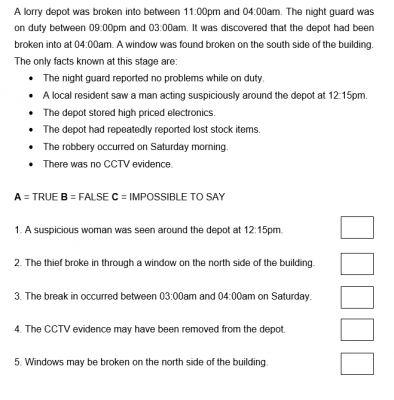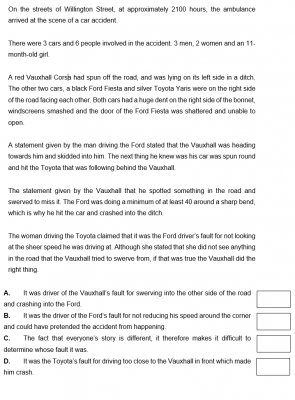Before you become a police officer in the UK, you’ll need to pass a number of assessments and police aptitude tests. One of these is the police officer verbal reasoning test, which assesses your ability to read a piece of text and make inferences based on the information provided.
The verbal reasoning test consists of 28 questions, and is 30 minutes long. All of the questions in this test are multiple choice. Moreover, the test is divided into two sections. In Section A, each question has 3 possible answers, only one of which is correct. In Section B, each question has 4 possible answers. Again, only one of these answers can be correct.
The way you answer questions in Section A is quite different to how you need to response to questions in Section B. Let’s begin with how Section A works.
Police Officer Verbal Reasoning Test – Section A
In this question, you will be given a short passage to read. It’s usually only a few sentences long, but has a lot of information packed into it. Below the text will be a series of statements, each with a box next to it. In this section, you will need to figure out whether each of the statements are true, false, or impossible to know based on the information provided:
• If you think the statement is true based on the information in the passage, you must put an ‘A’ in the box.
• If you think the statement is false based on the information in the passage, you must put a ‘B’ in the box.
• If you believe that it is impossible to say whether the statement is true or false based on the information provided, then you must put a ‘C’ in the box.
Bear in mind that the passage can be presented in a couple of ways. It might be one, solid paragraph, or the information may be split into bullet points. Take a look at the following example so you can familiarise yourself with the layout of the questions:

So, you need to figure out which statements are true, false, and impossible to know based on the passage given. Make sure to re-read the passage carefully so that you don’t miss any key details. The answers will be available at the end of this article.
Police Officer Verbal Reasoning Test – Section B
Like Section A, the questions in Section B will each be based on a passage. You will need to make in inference from this material. These passages are much longer than those in Section A, so be ready to read a larger piece of text.
For this section, you will be given for potential answers for each question. You will need to tick the statement which best matches the scenario detailed in the passage. Try your hand at the following example and see how you fare:

Conclusion
There aren’t any quick tricks to success in the verbal reasoning test. You simply need to practice hard at the questions, become familiar with their layout, and get used to picking out key pieces of information and using them to figure out what’s true and what’s false. If you’d like more practice and
police verbal reasoning test examples, as well as other police officer assessment exercises, you can check out our Police Tests Book.
Answers
Section A
1. False
2. Impossible to say
3. Impossible to say
4. True
5. True
Section B
1. C